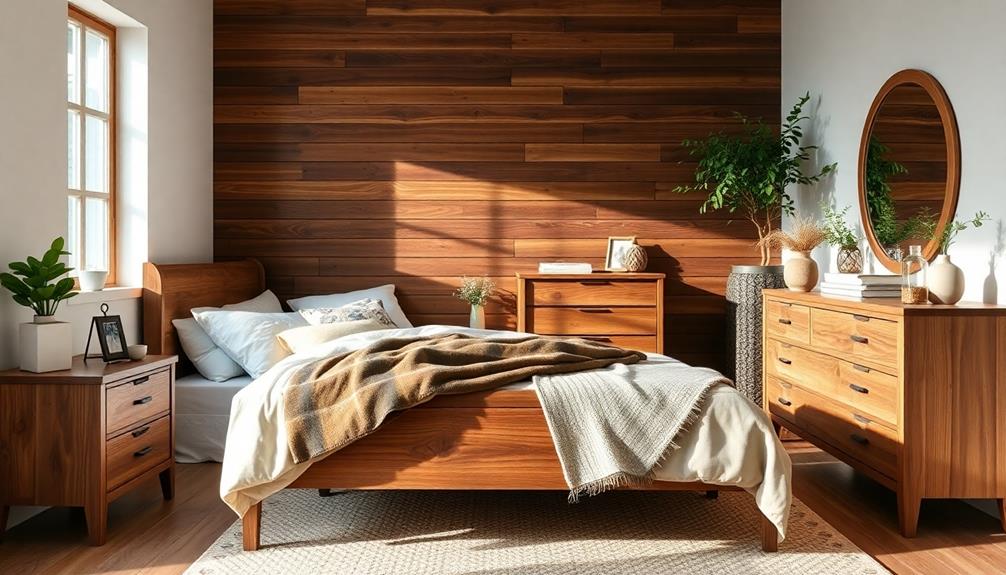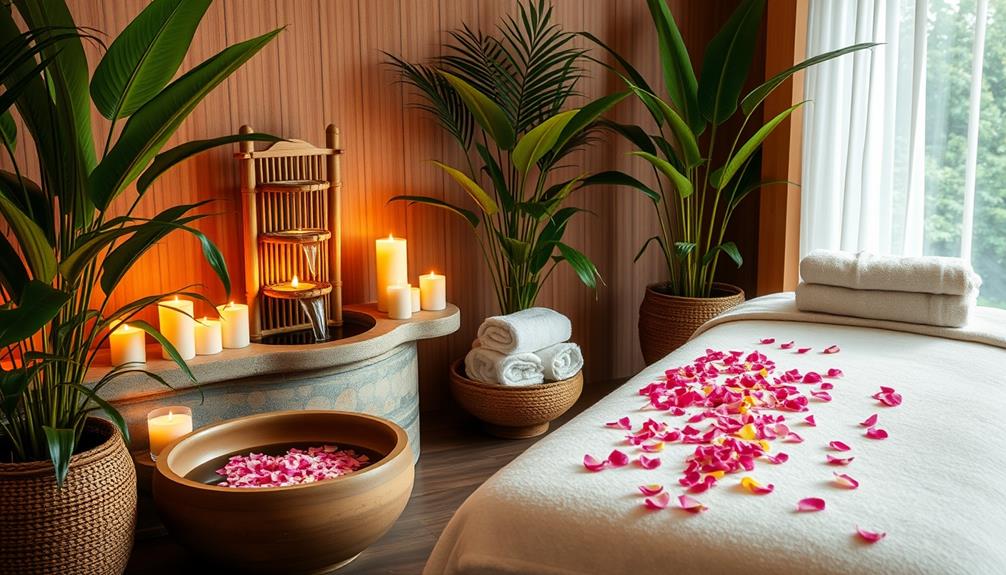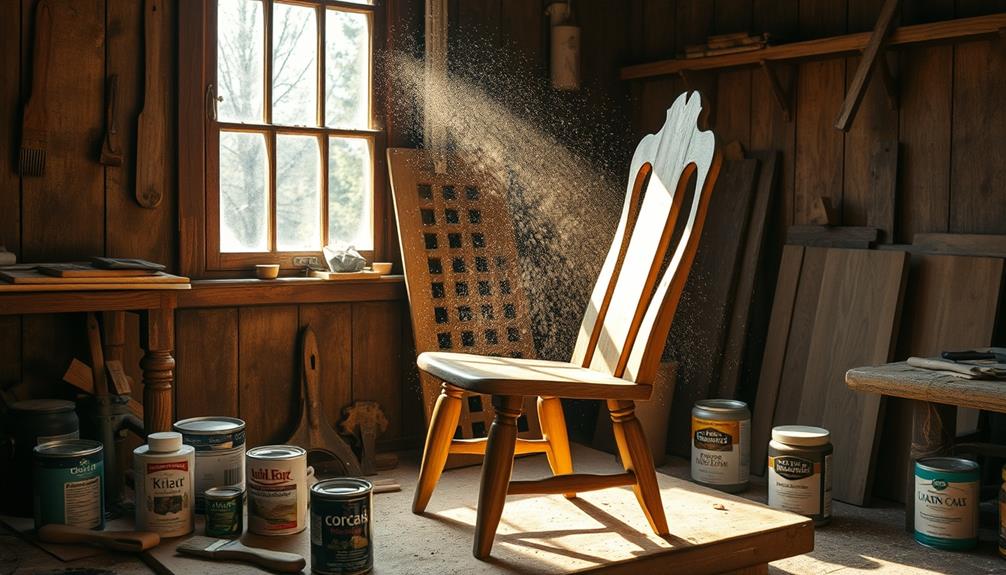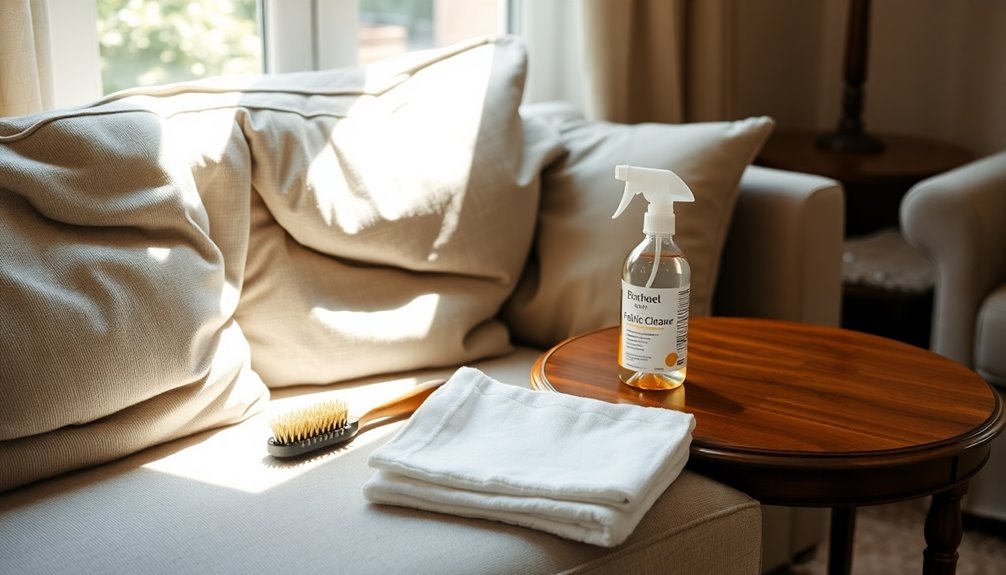Combining different types of wood furniture in your bedroom can create a cozy and welcoming environment. Begin by finding a balance between light and dark woods; aim for approximately 60% light wood and 40% dark wood for a harmonious look. Pay attention to the grain and texture of each piece – pairing smooth finishes with rustic textures can add visual interest. Stick to complementary wood tones by choosing pieces with similar undertones to ensure a seamless blend. Position larger items like the bed at the center of the room and arrange nightstands symmetrically for a sense of balance. Incorporate textiles and decor that reflect the colors of your furniture to bring everything together. There are endless possibilities to perfecting your mix of wood furniture!
Key Takeaways
- Choose wood types with complementary undertones to ensure a cohesive look, such as pairing oak with walnut or pine with cherry.
- Balance light and dark woods by using a 60% light to 40% dark ratio for visual harmony in the space.
- Incorporate varying textures by mixing smooth and rustic finishes, enhancing depth and character in your furniture arrangement.
- Arrange furniture symmetrically around a focal point, such as the bed, to create a balanced and visually appealing layout.
- Use textiles and accessories in coordinating colors to unify the wood tones and enhance the overall aesthetic of the bedroom.
Understanding Wood Furniture Types
When choosing wood furniture for your bedroom, how do you know which type is right for you? Understanding the different wood types can help you make the best decisions.
Oak is a sturdy option, known for its durability, making it perfect for key pieces like bed frames and dressers. If you prefer something lighter and more casual, pine offers an affordable choice that adds a rustic charm to your space.
Additionally, incorporating vintage and antique furnishings can enhance the authenticity of your decor, making it feel more cohesive with your overall style, especially if you're embracing modern farmhouse decor trends. These unique pieces often serve as conversation starters and can seamlessly bridge the gap between **classic versus modern design styles**, adding depth and personality to your space. Blending the warmth of aged, time-worn furniture with sleek, contemporary elements creates a balanced atmosphere that feels both inviting and stylish. This juxtaposition ensures your home remains timeless while still reflecting current design trends.
Walnut, with its rich dark tones, brings elegance and sophistication, ideal for accent pieces or statement furniture in your bedroom. If you're aiming for warmth, cherry wood's reddish-brown hue creates a cozy atmosphere, perfect for inviting relaxation.
When mixing different wood tones, consider how these wood types work together to achieve a cohesive look. Pairing oak with walnut can balance strength with elegance, while combining pine and cherry can create a unique contrast that feels inviting and casual.
Importance of Grain and Texture
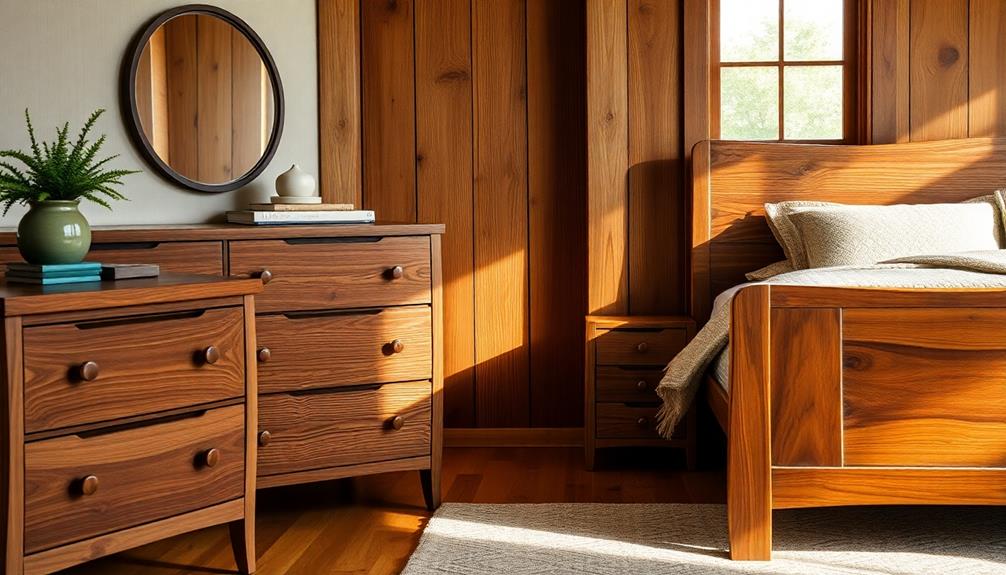
When you mix wood furniture, grain patterns play a vital role in shaping the room's overall look.
By combining different textures, like a smooth bed frame with a rustic dresser, you can create visual interest that elevates your space.
Incorporating elements of innovative design can also enhance this mix, allowing for a more dynamic and personalized aesthetic.
Additionally, choosing complementary grains and colors can enhance the harmony in your bedroom design.
Grain Patterns Impact Aesthetics
The aesthetic appeal of a bedroom can transform dramatically based on the grain patterns of wood furniture. Larger, more prominent grains tend to lend a rustic and casual feel, while finer grains contribute to a formal and sophisticated look.
When you mix furniture, opting for similar grain patterns helps create a cohesive appearance, tying the room together seamlessly. However, introducing contrasting textures can add visual interest and depth to your overall design. Understanding how to create a captivating narrative around your furniture choices enhances the overall theme of your space.
For instance, pairing a sleek walnut bed frame with rough-hewn pine nightstands showcases the beauty of complementary pieces, enhancing the uniqueness of each item. Understanding the character and direction of grain patterns is essential for achieving balance in your space.
For example, combining a piece with vertical grain alongside one with horizontal grain creates an engaging interplay of textures.
Incorporating varied grain patterns throughout your bedroom not only enriches the visual experience but also prevents a monotonous look. By thoughtfully selecting wood furniture with distinct grain patterns, you can elevate the overall design, making your bedroom feel inviting and well-curated.
Texture Contrast for Interest
Incorporating texture contrast in your bedroom design adds depth and visual intrigue, making the space feel more dynamic. Mixing wood tones and experimenting with different textures can elevate your bedroom decor greatly.
By combining different wood pieces with varying grain patterns, you can create an enthralling focal point. For instance, pairing a rough-hewn reclaimed wood piece with a sleek, polished walnut table introduces an engaging juxtaposition that adds character.
Consider using wood tones that feature warm undertones, like cherry, alongside cooler oak. This not only enriches the overall design but also prevents a monotonous appearance.
Adding textiles, such as upholstered chairs or soft bedding, further softens the look of wood grain while providing a balanced contrast in texture.
Don't shy away from experimenting with different textures—mix smooth surfaces with tactile elements like wicker or rattan. This combination creates a dynamic aesthetic that draws the eye and invites touch.
Ultimately, the key is to focus on texture contrast, allowing the unique characteristics of each wood piece to shine and enhance the visual interest in your bedroom.
Complementary Textures and Colors
Choosing complementary textures and colors is essential for creating a harmonious bedroom design that feels cohesive and inviting. When mixing wood, focus on the undertones of the wood—whether warm, cool, or neutral—to guarantee the pieces work together seamlessly. By selecting similar warm tones, you can enhance the room's overall cohesion while still adding visual depth.
Experiment with different combinations of wood textures to create interest. For instance, pairing a smooth walnut table with a rough reclaimed pine bookshelf can introduce dynamic contrasts that prevent monotony. Using similar wood textures strategically helps maintain balance, while varied textures keep the space engaging.
Incorporating textiles, like bedding and rugs, can also soften shifts between different wood finishes. This approach not only unifies the overall design but also enhances comfort.
Balancing Light and Dark Woods
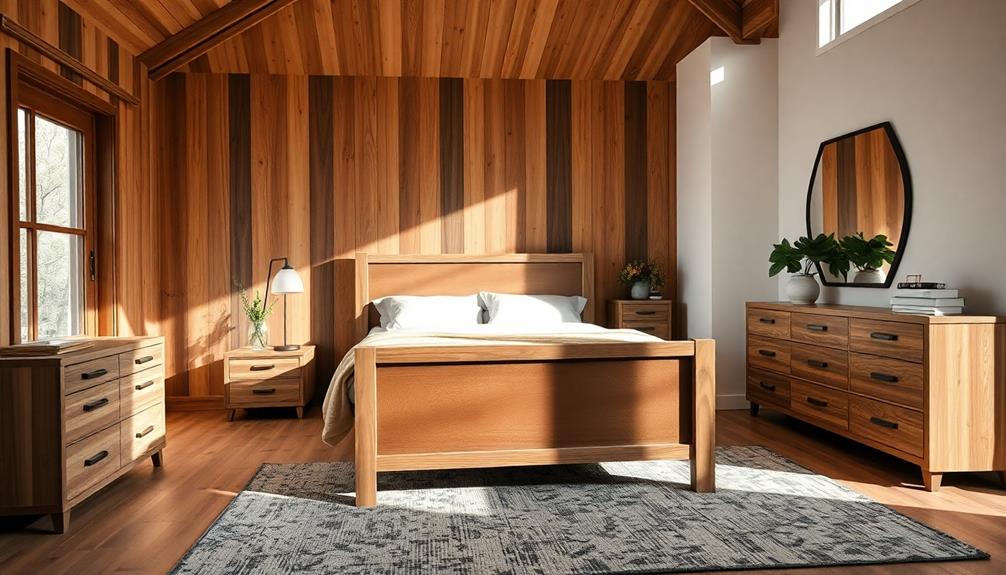
Balancing light and dark woods in your bedroom can transform the space into a visually dynamic retreat. To achieve this balance, pair dark wood furniture pieces, like a mahogany bed frame, with lighter wood accents, such as a pine nightstand. This striking contrast creates visual interest while preventing the room from feeling too heavy or monotonous.
Aim for a ratio of about 60% light wood to 40% dark wood to maintain harmony.
To further enhance this balance, place light wood pieces on opposite sides of the room from darker ones. This layout not only guides the eye throughout the space but also creates a cohesive flow. Incorporating a unifying element, like a shared wood finish or color undertone, can seamlessly blend both light and dark wood tones.
Don't forget to experiment with varying textures and shapes among your light and dark wood furniture pieces. This adds depth to your design elements and prevents a flat appearance. Additionally, incorporating various finishes like matte, gloss, or distressed wood can further enhance the character of your space. When choosing between different tones of wood, balance is key, and this can be achieved by layering complementary textures and forms. If you’re interested in a hands-on project or learning **how to build wooden furniture**, consider starting with simpler items like stools or shelves before advancing to more complex pieces like tables or dressers.
Identifying Complementary Wood Tones
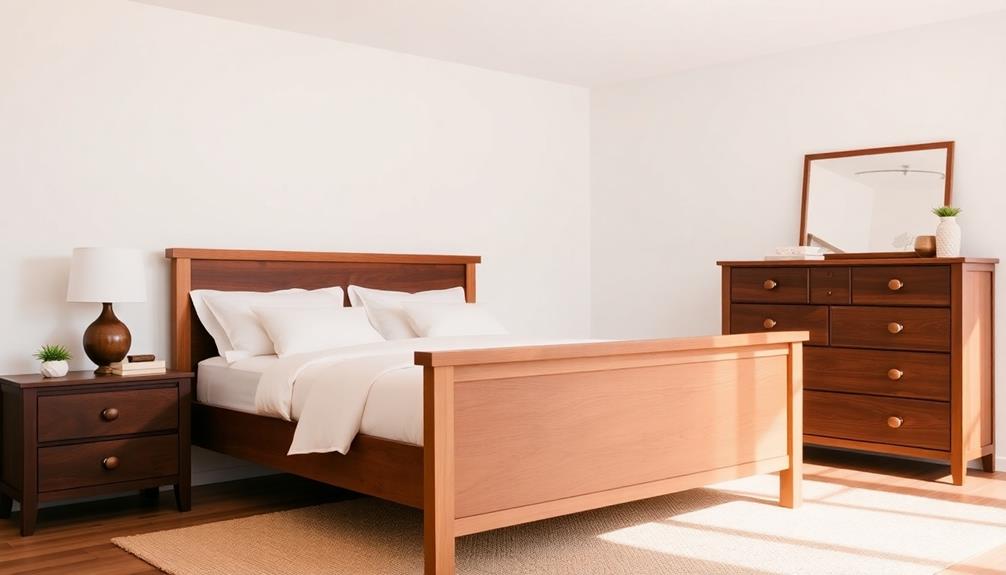
Identifying complementary wood tones is essential for creating a harmonious bedroom design. Start by identifying the dominant wood tone, often found in your flooring or larger furniture pieces. This will serve as your reference point.
If you prefer a cozy atmosphere, go for warm wood tones like cherry or oak. For a more modern feel, consider cool tones like walnut or ash. Pay attention to wood undertones; reds and yellows indicate warm tones, while greys and cool hues signify cool tones. This knowledge helps you achieve a cohesive design by effectively matching or contrasting these tones.
To avoid visual chaos, limit the number of different wood types you use. Aim to repeat each tone at least twice in the space, which creates balanced cohesion. A color wheel can be a useful tool for determining complementary wood tones, ensuring your selected pieces enhance each other.
Don't forget to incorporate different textures and grain patterns, as these variations can add depth and interest to your bedroom. By focusing on these elements, you'll create a beautifully curated space that feels intentional and inviting.
Arranging Furniture for Balance
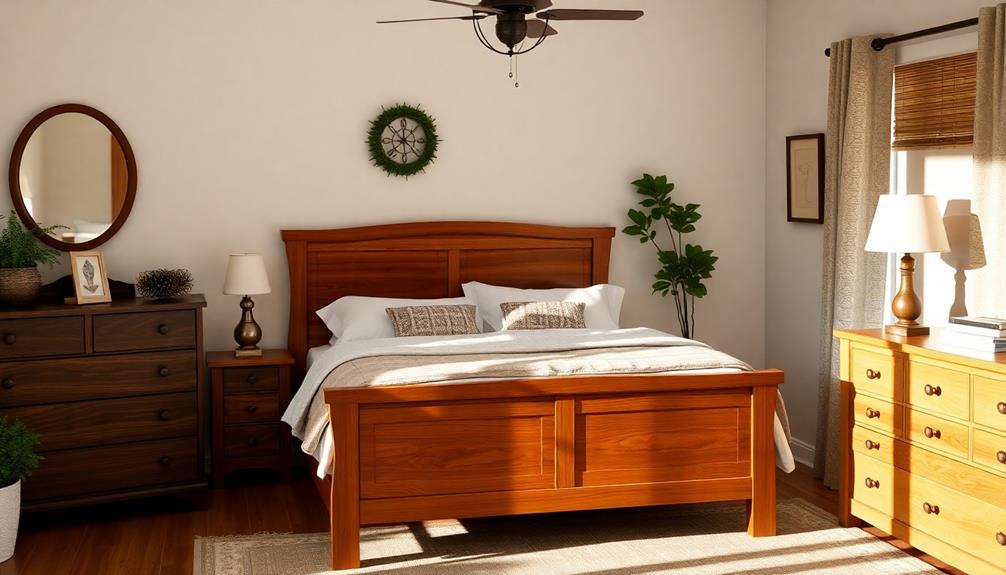
To create a balanced bedroom, start by positioning larger pieces like your bed as focal points.
Place nightstands and dressers symmetrically around the bed to enhance harmony and stability.
This thoughtful arrangement not only promotes visual interest but also improves the overall flow of the space.
Symmetrical Furniture Placement
When you arrange furniture in your bedroom, creating a sense of symmetry can greatly enhance the room's overall aesthetic.
Symmetrical furniture placement not only promotes visual harmony but also establishes balance, making your space feel cohesive and inviting. Here are some tips to achieve that: Consider arranging living room furniture in pairs, such as matching armchairs or identical side tables, to create a sense of uniformity. Additionally, centering key pieces like the sofa around a focal point, such as a fireplace or a large window, can help ground the space while maintaining an organized flow.
- Position larger furniture pieces, like the bed, centrally as the focal point.
- Arrange nightstands and dressers symmetrically around the bed to maintain a cohesive look.
- Keep similar elements on both sides, such as matching lamps or artwork, to balance the visual weight.
- Use complementary wood tones for your nightstands and dressers to reinforce symmetry while mixing and matching different materials and finishes.
Focal Points Awareness
Understanding the focal point in your bedroom is vital for arranging furniture that creates balance and harmony. Start by identifying your focal point, like the bed or a striking piece of artwork. Arrange other furniture symmetrically around it to enhance the overall visual appeal. Position larger items, such as dressers or nightstands, close to this focal point to establish a cohesive flow throughout the space.
To maintain balance, use contrasting wood tones in your furniture choices. For instance, lighter wood accents can be placed opposite darker pieces to create a dynamic yet cohesive design. It's important to be mindful of the visual weight across the room.
Additionally, make sure there's ample space for movement around the focal point. Each piece should serve a purpose, contributing to both aesthetics and functionality without overcrowding the area.
Here's a quick reference table to help you visualize these concepts:
| Furniture Type | Recommended Placement | Wood Tone Consideration |
|---|---|---|
| Bed | Centered | – |
| Nightstands | Flanking the bed | Contrasting wood tones |
| Dresser | Near the focal point | Balance with lighter accents |
| Accent Chair | Adjacent to the focal | Lighter or darker contrast |
| Decorative Items | Around focal point | Enhance visual appeal |
Practical Shopping Tips
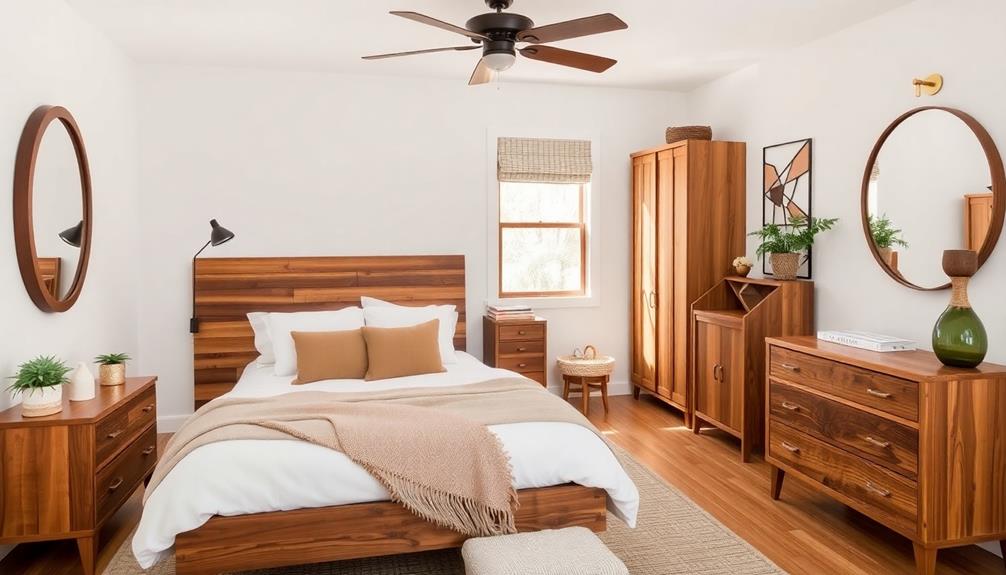
Shopping for wood furniture can be a rewarding experience, especially if you keep a few practical tips in mind.
To guarantee you mix and match effectively, consider these strategies:
- Bring a wood sample or photo: This helps you match the undertones of new pieces with your existing furniture.
- Obtain samples from the store: Compare finishes in different lighting conditions to see how they interact with your space.
- Use images of your bedroom: When shopping online, visual comparison helps you assess how new furniture fits with your current setup.
- Purchase multiple items for side-by-side comparison: This allows you to see how different wood types and colors work together in a cohesive look.
Maintaining Your Wood Furniture
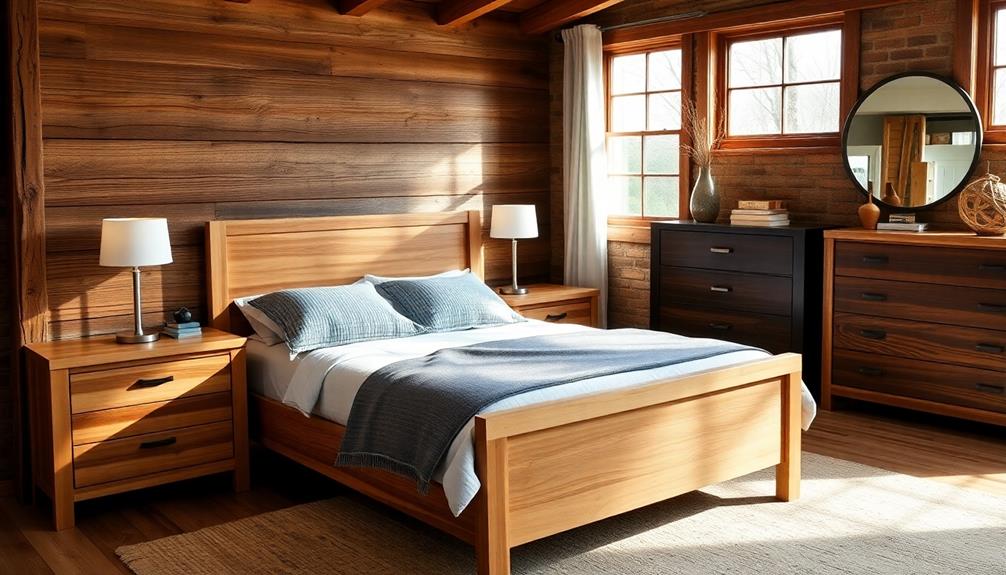
To keep your wood furniture looking its best, regular maintenance is essential. Start by dusting with a soft cloth to remove dirt and grime, then polish it with appropriate wood care products to maintain its luster and appearance. Avoid direct sunlight, as UV rays can cause fading and warping over time.
Using coasters and placemats under hot or wet items helps prevent water rings and heat marks, which can damage the surface. Invest in felt pads or furniture protectors to prevent scratches on both your furniture and the floor beneath, especially for heavy items like dressers and beds.
Regularly check for signs of wear or damage, such as loose joints or nicks. Address these issues promptly to extend the lifespan of your wood furniture. Here's a quick reference table to support your maintenance efforts:
| Action | Frequency | Purpose |
|---|---|---|
| Dusting | Weekly | Remove dirt and maintain shine |
| Polishing | Monthly | Enhance appearance |
| Inspect for damage | Monthly | Identify and fix issues early |
| Use coasters | Always | Prevent water and heat damage |
| Use felt pads | Always | Prevent scratches |
Enhancing Room Aesthetics With Accessories
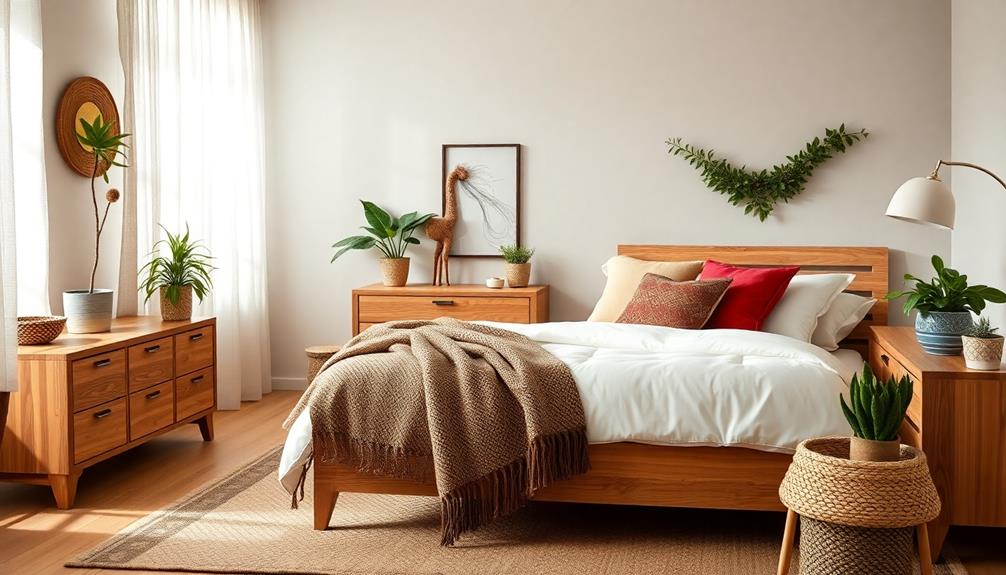
Accessories play an essential role in enhancing the aesthetics of your bedroom, especially when mixing and matching wood furniture. By thoughtfully selecting the right pieces, you can create a harmonious atmosphere that brings out the best in your wood tones.
Consider incorporating these elements:
- Textiles: Use bedding and curtains in complementary colors to unify different wood pieces.
- Accent Chairs: An accent chair in a similar wood tone can create cohesion while adding seating.
- Lighting Fixtures: Choose wooden lighting fixtures to enhance warmth and provide an inviting glow.
- Wall Art: Select wall art that incorporates colors from your furniture, adding personality and visual interest.
These accessories not only add depth to the design but also soften the overall look, preventing your space from feeling rigid.
Decorative pillows and throws can introduce various textures and colors, making the room feel cozy and inviting.
Frequently Asked Questions
How to Mix Match Furniture in a Bedroom?
To mix and match furniture in your bedroom, choose a dominant style, vary shapes and sizes, and incorporate different textures. Avoid matching pieces and add accessories like rugs to create a cohesive and inviting space.
Can You Mix Light and Dark Wood Furniture in a Bedroom?
Yes, you can mix light and dark wood furniture in your bedroom. Just guarantee the tones balance well, repeating each wood style to create harmony while using textiles to soften contrasts and add warmth.
Can You Mix Different Wood Furniture in a Room?
Did you know that 72% of interior designers believe mixing wood tones adds character to a space? You can mix different wood furniture in a room, but balance and harmony are key to achieving a cohesive look.
Do Woods Have to Match in Bedroom?
No, woods don't have to match in your bedroom. Mixing different wood tones can create visual interest and depth, making the space feel more dynamic. Just balance light and dark tones for harmony.
Conclusion
By mixing and matching wood furniture in your bedroom, you're weaving a tapestry of warmth and character that invites comfort. Embrace the dance of light and dark tones, letting the grains tell their unique stories. Remember, balance is key—like a well-crafted symphony, each piece should harmonize with the next. With a touch of creativity and care, you'll transform your space into a cozy sanctuary that reflects your personal style and flair.
